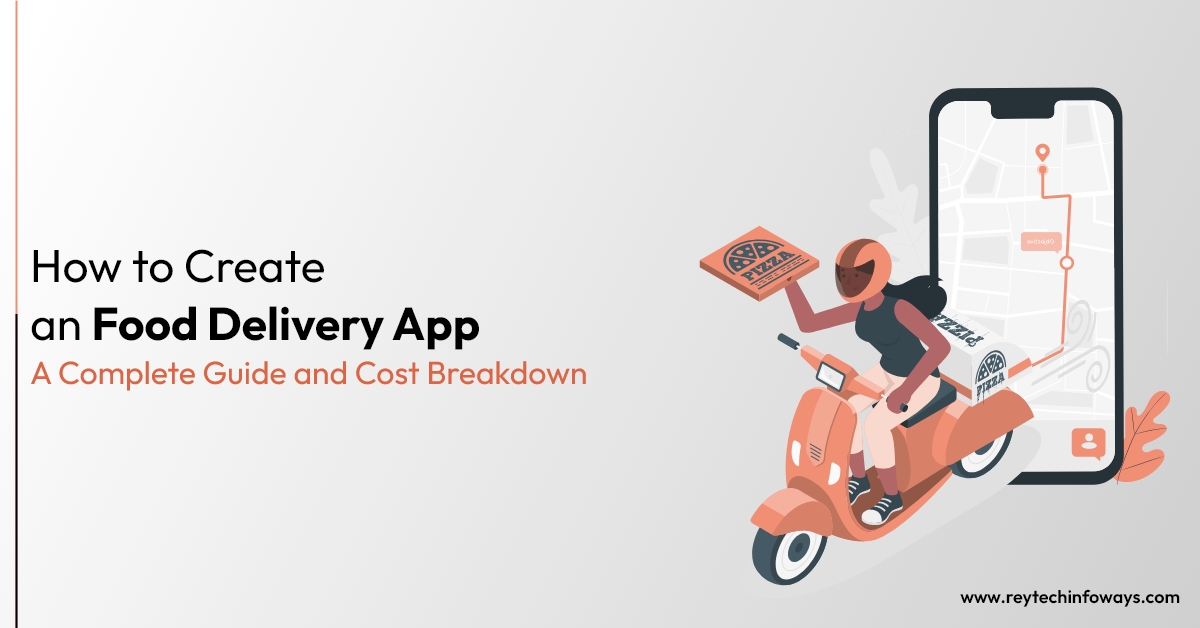Mobile App Development
How to Create an Food Delivery App - A Complete Guide and Cost Breakdown

Food delivery app development is interested in building a mobile application that allows users to order food from provincial restaurants and deliver it to their desired location. Food delivery apps and restaurant delivery/takeout software are platforms created to promote connections between consumers and local facilities such as restaurants, grocery stores, and convenience stores. They present an opportune means for individuals to order food or products for delivery to their area.
These answers entrust users by permitting them to select delivery preferences, including timing and location, and also offer complete search abilities to monitor the entire delivery revolution from start to finish.
Food delivery apps deliver multiple benefits that can enormously improve a restaurant's earnings when cooperating with third-party delivery services. They help small restaurants in Expanded Customer Reach, Enhanced Convenience, Increased Visibility, Outsourced Delivery, Multiple Payment Options, etc.
The Steps Involved in Creating a Food Delivery App
Market Research and Analysis by executing thorough market investigation to understand your niche. Choosing a Business Model includes using your own transport vehicles, partnering with taxi assistance or outward couriers, or depending on the food service for delivery. Monetize Your App by developing a transparent monetization process for your app to secure sustainability.
Define the fundamental components and APIs your app will contain, concentrating on the needs of clients, restaurants, and couriers. Unite with a professional food delivery app evolution company to execute your project. Pick the appropriate technology stack founded on your app's functionality and conditions. Choose the estimated product costs based on the development firm, location, and app complexity.
The Different Types of Food Delivery Apps
Delivery-Service Aggregators
Approximately 15 years ago, aggregators emerged as "third-party" applications within the selected food delivery service industry. These aggregator platforms provide customer service through a cooperative interface, whether a mobile app or a web application. Operating as arbitrators between food service providers and customers, aggregator apps facilitate relationships between customers and nearby restaurants, permitting them to select from different cuisine options.
Ride-Hailing Delivery Service Apps
Like aggregators, ride-hailing delivery food service apps deliver users exceptional flexibility when scanning menus and positioning orders via mobile apps or websites. What places them asunder is their sharp focus on logistics. Small businesses requiring more aid for in-house delivery services can be delighted by these new delivery apps. Hence, this is an exciting option for diners yet to embark on meal delivery.
One of the key benefits of this service standard is its cost-effectiveness. There are no extra costs such as driver service fees, vehicle upkeep, or insurance compensation payments for restaurants to stress about; these responsibilities are shouldered by the ride-hailing service providers.
Full-Stack Delivery Apps
Full-stack delivery apps are one of the most current products in the food delivery industry. Unlike aggregators or newer app-based delivery benefits, these complete delivery apps bring the absolute kitchen experience to your doorstep. They don't depend on close alliances with third-party commodities; they have full control over every facet of the process, from meal practice to final food delivery. This usefulness model emphasizes seamless consumer relations, culinary rehearsal, and efficient logistics. You can be directed to the concurrent diagram to comprehend how it operates.
The Cost of Creating a Food Delivery App
The expense of developing a food delivery app can deviate considerably, varying from roughly $40,000 to $300,000 or even higher. Developing an Android or iOS diner food delivery application in India generally costs between $3,000 and $15,000. It's essential to cite that mixed factors affect the final outcome cost.
The Challenges of Creating a Food Delivery App
The food delivery enterprise is fiercely competitive, making pricing strategies demanding. New startups often need to accept higher-margin steps to attract users, impacting profitability. Unpredictable food quality during delivery is a common concern, necessitating thorough packaging systems. Logistics management is a hurdle, particularly in handling high-order volumes and prioritizing deliveries.
Selecting a stable customer base amid a growing contest is tough; referral schedules and user-friendly apps can help. Partnering with quality eateries is time-consuming; onboarding specialists can facilitate this process. Existing demand giants pose a threat; startups must prioritize customer satisfaction.
Determining effective transaction strategies and meeting customer expectations is essential. Punctual deliveries and order precision are critical for customer happiness and retention. Utilizing technology for path optimization and order administration can enrich these elements of the business.
Conclusion
Incorporating food delivery apps into a diner's functioning is a strategic scheme, allowing a broader clientele, providing added convenience, and streamlining the complexities of food delivery. This system designates restaurants to focus on their primary culinary functions while assigning the logistics to superficial platforms.